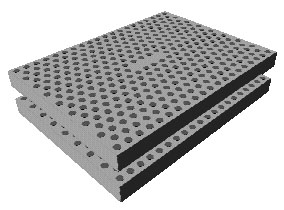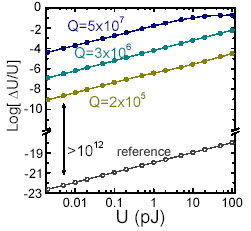Masaya Notomi and Hideaki Taniyama
Optical Science Laboratory
Recently, ultrahigh-Q and simultaneously ultra-small optical cavities
have been realized by photonic crystals [1]. In such ultrahigh-Q nanocavities,
various light-matter interactions are expected to be greatly enhanced.
We have theoretically found that we can convert optical energies into mechanical
energies extremely efficiently by employing specially-designed photonic-crystal
nanocavities [2]. Our result demonstrates that one can introduce mechanical
displacement by extremely weak light, and indicates possibilities towards
ultra-efficient optical micro-machines in future.
Figure 1 shows our sample structure, which is a point defect cavity of
a double-layer photonic crystal. It is practically the same as our ultrahigh-Q
photonic-crystal cavity design except an air slit is inserted in the center
of the slab. This cavity is special because one can largely change the
resonant wavelength by slight change of the slab spacing (slit width) without
deteriorating cavity Q. Owing to this feature, an optical pulse captured
in this cavity can generate extraordinary large radiation force (〜 1µN
per 1 pJ), because this force is determined by the spatial derivative of
the electromagnetic energy in the cavity. Furthermore, this large force
can do a large mechanical work due to the long cavity photon lifetime.
Consequently, the optical energy of the optical pulse is converted to the
mechanical energy very efficiently. We calculated this efficiency assuming
realistic parameters, as shown in Fig. 2. Generally, such opto-mechanical
energy conversion is intrinsically very inefficient (〜10-12) because of the mass-less
nature of light (except photon rockets having relativistic speed). Figure 2
shows that the efficiency can reach up to 10%. Such extremely-high efficiency
is only possible for mechanical displacement incorporated to ultrahigh-Q and
ultrasmall cavities.
When the optical energy is converted to mechanical, the frequency of
light in the cavity is lowered. In other words, one can realize wavelength
conversion of light using the reverse process. Our numerical calculation
shows that large wavelength conversion (larger than 20% of the original
wavelength) is indeed possible. Last year, we have reported that adiabatic
wavelength conversion is possibly by dynamically tuning the resonance frequency
of a cavity [3]. In fact, the present opto-mechanical process is physically
identical. That is, very efficient optical micromachines are intrinsically
very efficient opto-mechanical wavelength converters.
[1] E. Kuramochi, et al., Appl. Phys. Lett. 88 (2006) 041112.
[2] M. Notomi, et al., Phys. Rev. Lett. 97 (2006) 023903.
[3] M. Notomi, et al., Phys. Rev. A73 (2006) 051803(R).
 |
 |
||||
|
|